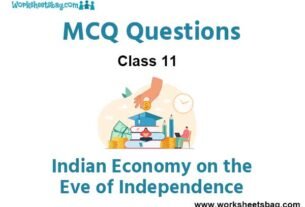Please refer to Culture and Socialisation MCQ Questions Class 11 Sociology below. These MCQ questions for Class 11 Sociology with answers have been designed as per the latest NCERT, CBSE books, and syllabus issued for the current academic year. These objective questions for Culture and Socialisation will help you to prepare for the exams and get more marks.
Culture and Socialisation MCQ Questions Class 11 Sociology
Please see solved MCQ Questions for Culture and Socialisation in Class 11 Sociology. All questions and answers have been prepared by expert faculty of standard 11 based on the latest examination guidelines.
MCQ Questions Class 11 Sociology Culture and Socialisation
Question. Which of the following is not a feature of ‘Dionysian’ cultures?
(a) Ostentatiousness
(b) Excess
(c) Restraint
(d) Lavishness
Answer
C
Question. ________ is the transmission of cultural items or social practices from one group or society to another
(a) Diffusion
(b) Research
(c) Examination
(d) Discovery
Answer
D
Question. __________ refers to the wide range of cultural differences found between and within nations.
(a) Cultural joy
(b) Cultural diversity
(c) Cultural shock
(d) Cultural familiarity
Answer
B
Question. Homogeneous societies consist of people who share a common _________.
(a) Culture
(b) Land
(c) Livelihood
(d) Coastline
Answer
A
Question. When people in a society are dissimilar in regard to social characteristics such as religion, income, or race/ ethnicity, they belong to a __________ society.
(a) Homogenous
(b) Heterogenous
(c) Kindred
(d) Congruent
Answer
B
Question. Which of the following factors contribute to cultural diversity in a society?
(a) Tourism
(b) Commerce
(c) Immigration
(d) Art
Answer
C
Question. People who share distinguishing attributes, beliefs, values, and/or norms that set them apart in some significant manner from the dominant culture form a
(a) Subculture
(b) Monoculture
(c) Biculture
(d) Multiculture
Answer
A
Question. Who introduced the concept of ‘folkways’?
(a) Raymond Williams
(b) William Graham Sumner
(c) William F. Ogburn
(d) William I. Thomas
Answer
B
Question. The idea that a person’s beliefs, values, and practices should be understood based on that person’s own culture, rather than be judged against the criteria of another is called
(a) Cultural absolutism
(b) Cultural relativism
(c) Cultural universalism
(d) Cultural despotism
Answer
B
Question. The development of one or more cultures from simpler to more complex forms is called
(a) Cultural change
(b) Cultural progress
(c) Cultural development
(d) Cultural evolution
Answer
D
Question. Which of the following is not a feature of youth subcultures?
(a) it is a culture of leisure rather than work
(b) youth groups are particularly interested in social issues
(c) social relationships are organized around the peer group
(d) youth groups are particularly interested in style.
Answer
B
Question. Which of the following is an Indian civilization?
(a) Incan civilization
(b) Mayan civilization
(c) Indus valley civilization
(d) Aztec civilization
Answer
C
Question. The culture of the upper classes is known as
(a) Lofty culture
(b) High culture
(c) Positive culture
(d) Upper culture
Answer
B
Question. The culture consumed by many people in all classes is known as
(a) Commercial culture
(b) Simple culture
(c) Popular culture
(d) Conventional culture
Answer
C
Question. Gestures help us to express
(a) feelings
(b) ideas
(c) emotions
(d) all of the above
Answer
D
Question. Interpersonal relations and living arrangements can be best analysed through
(a) experimental method
(b) exploratory method
(c) genealogical method
(d) interview method
Answer
C
Question. When members of one cultural group borrow elements of another’s culture, it is called _________.
(a) Cultural appropriateness
(b) Cultural approximity
(c) Cultural affiliation
(d) Cultural appropriation
Answer
D
Question. __________ is the process by which different cultures are absorbed into a mainstream culture.
(a) Assimilation
(b) Association
(c) Affiliation
(d) Alliance
Answer
A
Question. Multiculturalism refers to a situation where
(a) ethnic groups exist separately and share equally in economic and political life
(b) ethnic groups are engaged in constant strife
(c) ethnic groups are unequally represented in public life
(d) None of the above
Answer
A
Question. Which of the following is a characteristic of early human societies?
(a) They were very dependent on their physical environment
(b) They had sophisticated religious systems
(c) They were stratified to a great extent
(d) They could manipulate their surroundings to a great extent
Answer
A
Question. Exchanges of cultural features with foreign cultures is called
(a) Assimilation
(b) Acculturation
(c) Diffusion
(d) Differentiation
Answer
C
Question. Cultural diversity and equality is achieved through
(a) Countercultures
(b) Monoculturalism
(c) Multiculturalism
(d) Cultural imperialism
Answer
C
Question. Which of the following is an antidote or a solution to ethnocentrism?
(a) Cultural relativism
(b) Cultural appropriation
(c) Cultural imperialism
(d) None of the above
Answer
A
Question. _________ allows wealthier categories of people to exercise some control over others.
(a) Popular culture
(b) Mass culture
(c) Dominant culture
(d) High culture
Answer
C
Question. A/An _______ is a system of interrelationships that connects individuals.
(a) Association
(b) Triad
(c) Dyad
(d) Society
Answer
B


